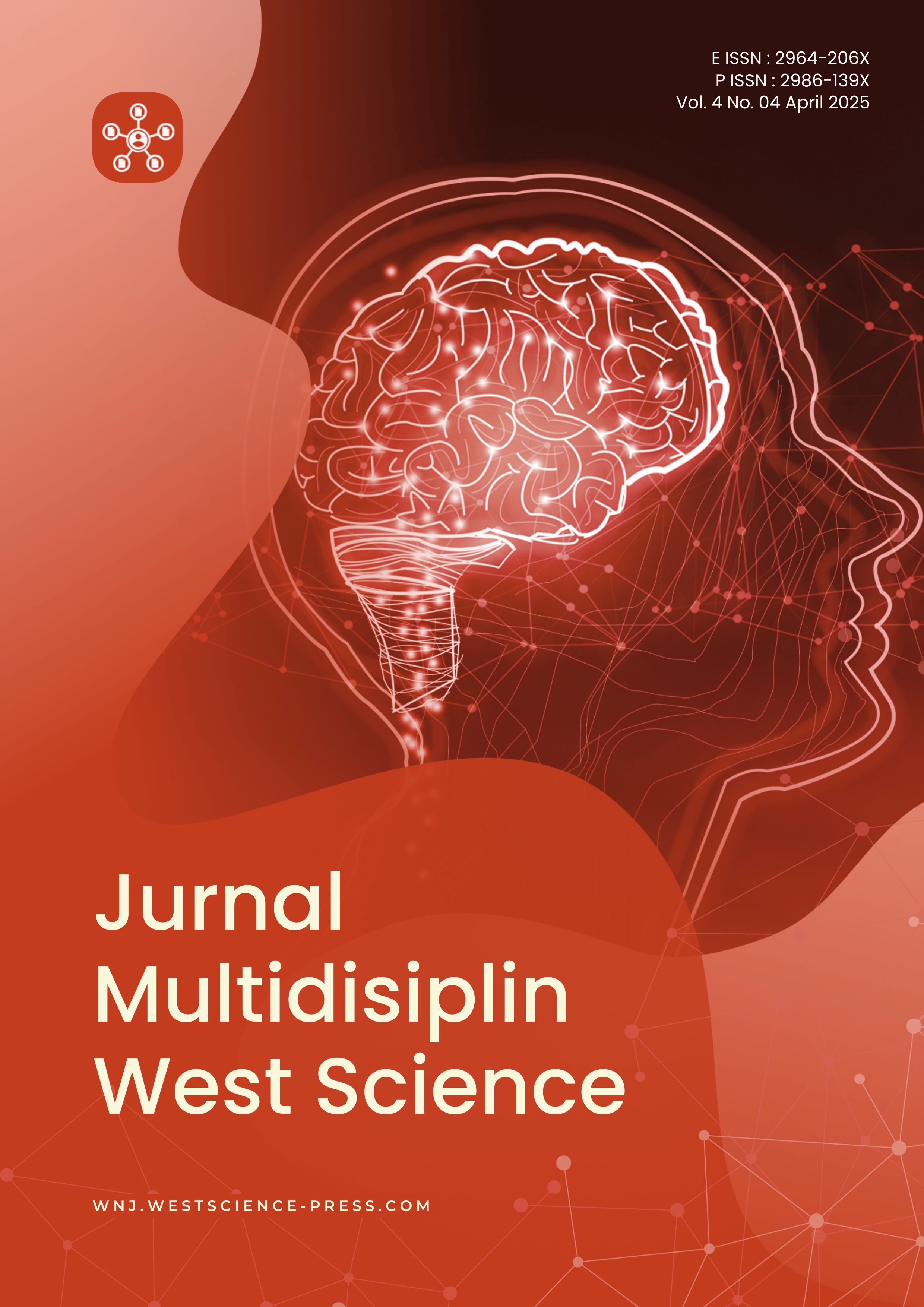Research in Language Education Context
DOI:
https://doi.org/10.58812/jmws.v4i04.2113Kata Kunci:
Research, Language Education, Language Education ResearchAbstrak
Research in the scientific area of language (e.g. linguistics, literature, and language education) has been carried out by many language practitioners in Indonesia, but few know clearly the focus areas of research in these branches of the language sciences. This paper aims to provide a comprehensive explanation of three things: first, research in the context of language education; second, to provide a clear and concise overview of the scientific area of focus in language education research; third, to justify the rationale for the need to conduct research in the area of language education. To achieve those objectives, the author has conducted a literature study by reading various references in the form of books and scientific articles. The results of the study show that the area of language research is basically divided into two scientific disciplines, namely linguistics and literature. Each of these scientific domains has its own branches consisting of sub-disciplines as the focus of research. Furthermore, language education research is identified as being in the linguistics area in the applied linguistics discipline consisting of 10 sub-focus research objects. This information is believed to be used as a basis and also a reference to clearly identify the scope of language education research conducted by researchers in the area of language education.
Referensi
Abidin & Kaharuddin. (2021). Analysis of Syariah Credit Card from Islamic Economic Perspective: Evidence from BNI Bank in Indonesia. Academy of Strategic Management Journal, 20 (4S), 1–11.
Andi, K., & Arafah, B. (2017). Using needs analysis to develop English teaching materials in initial speaking skills for Indonesian college students of English. The Turkish Online Journal of Design, Art and Communication (TOJDAC), Special Edition, 6(9), 419-436.
Arafah, H. B., & Bahar, A. K. (2015). The art of developing speaking as a performance (promoting formal uses of public speaking skills in English for making speeches and oral presentation). Yogyakarta: Trust Media.
Arafah, B., & Kaharuddin, (2019). The Representation of Complaints in English and Indonesian Discourses. Opción, 35, 501-517
Arafah, B., Kaharuddin, K., Mulyanto, M., Arifin, M. B., Rofikah, U., & B Ara-fah, A. (2021a). The idol: An innovative model for designing literature-based ELT materials. Linguistica Antverpiensia. 1, 2075-2090.
Arafah, B., Kaharuddin, K., Takwa, T., Arafah, N. B., Kadaruddin, K., & Marlina Raja Leba, S. (2021b). Promoting the Building up of Character Education Based on Literature, Culture, and Local Wisdom. Linguistica Antverpiensia. 1, 2129-2147.
Arafah, B., Rofikah, U., Kaharuddin, A., Room, F., Takwa, & Purwarno, P. (2023). Evaluating the Suitability of Printed Materials in the Context of Online Learning. XLinguae, 16(2), 16-32. DOI: 10.18355/XL.2023.16.02.02.
Babbie, E. R. (2020). The practice of social research. Cengage AU.
Bahar, K (2013a). The Communicative Grammar Translation Method: An Integrated Method of CLT and GT for Teaching English Communicatively and Accurately. Yogyakarta: Trustmedia.
Bahar, A. K. (2013b). The Communicative Competence-Based English Language Teaching. Yogyakarta: TrustMedia, 43(8), 64-79.
Bell, E., Bryman, A., & Harley, B. (2022). Business research methods. Oxford university press.
Bourne Jr, L. E., Kole, J. A., & Healy, A. F. (2014). Expertise: defined, described, explained. Frontiers in psychology, 5, 186-120.
Bryman, A., & Cramer, D. (2004). Quantitative data analysis with SPSS 12 and 13: A guide for social scientists. Routledge.
Butarbutar, R., Arafah, B., Marlina Raja Leba, S., Kaharuddin, K., F Sauhenda, A., & Monika, S. (2021). Using mobile-assisted language to encourage EFL learning among Indonesian learners of English. Linguistica Antverpiensia. 2; 766-779.
Daniel, B., Kumar, V., & Omar, N. (2018). Postgraduate conception of research methodology: implications for learning and teaching. International Journal of Research & Method in Education, 41(2), 220-236.
De Costa, P. I. (Ed.). (2015). Ethics in applied linguistics research: Language researcher narratives. Routledge.
Diah, A. (2019, January). A Descriptive Study on the Students’ Attitude toward English in a Multilingual Classroom. In 1st International Conference on Education and Social Science Research (ICESRE 2018) (pp. 1-6). Atlantis Press.
Fibiyani, F., & Pratiwi, T. L. (2023). Language Test Anxiety between Gender and Proficiency among Foreign Language Learners. IALLTEACH (Issues in Applied Linguistics & Language Teaching), 5(1), 40-47.
Giraldo Aristizábal, F. (2018). A diagnostic study on teachers’ beliefs and practices in foreign language assessment. Íkala, revista de lenguaje y cultura, 23(1), 25-44.
Gratton, C. & Jones, I. (2009) Research Methods for Sports Studies, 2nd edition, London: Routledge
Hiebert, J., Cai, J., Hwang, S., Morris, A. K., & Hohensee, C. (2023). Doing Research: A New Researcher’s Guide (p. 136). Springer Nature.
Ismail., Sunubi, A. H., Halidin, A., & Kaharuddin, A. (2020). Paraphrasing Technique To Develop Skill for English Writing Among Indonesian College Students of English. Sys Rev Pharm, 11(11), 291-297.
Jain, H. (April 6, 2023). Meaning and Scope of Educational Research. https://prepwithharshita.com. Retrieved on March 30, 2024. https://prepwithharshita.com/meaning-and-scope-of-educational-research/
Kadaruddin, Arafah, B., Ahmad, D., Kaharuddin, Iska. (2020). Word Wall Media: An Effective Teaching Technique to Enrich Students' Vocabulary in Secondary Level of Education, International Journal of Advanced Science and Technology, 29(5), 13228-13242.
Kaharuddin, A. (2019). The Power of English: Recognizing and Utilizing the Tremendous Impact of the English Language on the Community. English Language Teaching for EFL Learners, 1(1), 39-48.
Kaharuddin, A., & Latif, I. (2017). The Essential of Discourse Analysis for Teaching English as a Foreign Language. Yogyakarta: Trust Media Publishing.
Kaharuddin, A., Arafah, B., & Latif, I. (2018). Discourse analysis For English language teaching. LAP LAMBERT Academic Publishing.
Kaharuddin, A. (2018). The communicative grammar translation method: a practical method to teach communication skills of English. ETERNAL (English, Teaching, Learning, and Research Journal), 4(2), 232-254.
Kaharuddin, A., & Ahmad, D. (2018). English Phonetics for Indonesian Learners of English (An Essential Guide to Natural English Pronuncitation), Yogyakarta: TrustMedia.
Kaharuddin, Hikmawati & Arafah, B. (2019). Needs Analysis on English for Vocational Purpose for Students of Hospitality Department. KnE Social Sciences, 344-387.
Kaharuddin, Hasyim, M., Kaharuddin, Tahir, M., Nurjaya, M,. (2020a). Problematic English Segmental Sounds: Evidence from Indonesian Learners of English. Palarch’s Journal of Archaeology of Egypt/Egyptology 17(6). 9105-9114.
Kaharuddin, A. Ahmad, D., Mardiana, & Rusni. (2020b). Contributions of technology, culture, and attitude to English learning motivation during COVID-19 outbreaks. Systematic Reviews in Pharmacy, 11(11), 76-84.
Kaharuddin, (2021a). Linguistic Basic Theory and Roles in Englsih Languag Teaching. Jakarta: Prenada Media.
Kaharuddin, K. (2021b). Assessing the effect of using artificial intelligence on the writing skill of Indonesian learners of English. Linguistics and Culture Review, 5(1), 288-304. https://doi.org/10.37028/lingcure.v5n1.1555
Kaharuddin & Nanning, (2014). The problems of Indonesian college EFL learners in listening comprehension. Jurnal ilmu budaya, 2(2), 40-51.
Kaharuddin. (2024). The Psycholinguistics Approach: Contributions to English Language Pedagogy, Jurnal Multidsiplin West Science, 03 (2), 1911-1927.
Kaharuddin, M., Ahmad, D., & Sari, A. A. I. (2022). Examining the skill in writing descriptive text among Indonesian learners of English: The effects of task-based language teaching (TBLT). Journal of Language Teaching and Research, 13(1), 46-57.
Kaharuddin, Arafah., B, Nurpahmi, S., Sukmawaty, I. F. R., & Juniardi, Y. (2023). Exploring How Reading Aloud and Vocabulary Enrichment Shape English Speaking Skills Among Indonesian Learners of English. World Journal of English language, 13(8). 436-445.
Kaharuddin, K. (2025). Needs Analysis-Based Teaching Materials Development for English Speaking Skill Course in Tertiary Level of Education. Journal of Education Review Provision, 5(1), 12-27.
Kaharuddin, K., & Ismail, I. (2022). The use of ‘I-Do’methodology in integrating moral characters into the development of ELT materials for transactional speaking skills. Linguistics and Culture Review, 6(1), 1-29.
Kapur, R. (2018). Research methodology: Methods and strategies. Department of Adult Education and Continuing Extension, University of Delhi: New Delhi, India.
Kemendikbud RI, (2017). Prosedur Operasional Standar Penelitian Bahasa, Jakarta: Badan Pengembangan dan Pembinaan Bahasa.
Mardiana, Arafah, B., Ahmad, D., Kaharuddin., Room, F., & Barus, E. (2023). Time Allocation Effect on Test Scores for Academic Writing of Indonesian English Learners. Journal of Language Teaching and Research, 14(6), 1628-1636.
Kaharuddin, Ahmad, D., Mardiana., Latif, I., Arafah, B., & Suryadi, R. (2024). Defining the Role of Artificial Intelligence in Improving English Writing Skills among Indonesian Students. Journal of Language Teaching and Research, 15(2), 568-678.
Kaharuddin, (2024). Psycholinguistics in Language Pedagogy, Yogyakarta: TrustMedia.
National Research Council. (1999). Improving student learning: A strategic plan for education research and its utilization. National Academies Press.
Nielsen, S. (2011). Function-and user-related definitions in online dictionaries. Ivanovskaya leksikografischeskaya shkola: traditsii i innovatsii Ivanovo State University, 197-219.
Saunders, M., Lewis, P., & Thornhill, A. (2007) Research Methods for Business Students, 4th edition, UK: Pearson Education Limited.
Rofikah, U., Arafah, B., & Kaharuddin, A. (2022). Needs analysis as the cornerstone of the design and development of online language learning. Jurnal ilmu budaya, 10(1), 67-78.
Rizal, R. P., Damayanti, D. N., Debriyanti, N. C., & Sari, W. P. (2022). Research Trends in English Language Education from Ontological Perspective: A Systematic Review. Journal of English Language and Culture, 12(2). 113-122.
Slesinger, D. and Stephenson, M. (1930). The Encyclopaedia of Social Sciences. Vol. IX, MacMillan Publications.
Sugiyono. 2012. Metode Penelitian Kuantitatif kualitatif dan R&D. Bandung: Alfabeta.
Thomas, J. R., Martin, P., Etnier, J. L., & Silverman, S. J. (2022). Research methods in physical activity. Human kinetics.
Xiao, Y., & Zhi, Y. (2023). An exploratory study of EFL learners’ use of ChatGPT for language learning tasks: Experience and perceptions. Languages, 8(3), 212-230.
Wallen, N. E., & Fraenkel, J. R. (2013). Educational research: A guide to the process. Routledge.
Woody, C. (1927). The values of educational research to the classroom teacher. The Journal of Educational Research, 16(3), 172-178. DOI: 10.1080/00220671.1927.10879779
Yassi, A. H. & Kaharuddin (2018). Syllabus Design for English Language Teaching. Prenada Media. Jakarta.
Unduhan
Dimensions
Diterbitkan
Terbitan
Bagian
Lisensi
Hak Cipta (c) 2025 Kaharuddin Kaharuddin

Artikel ini berlisensiCreative Commons Attribution-ShareAlike 4.0 International License.






















 Instagram
Instagram 